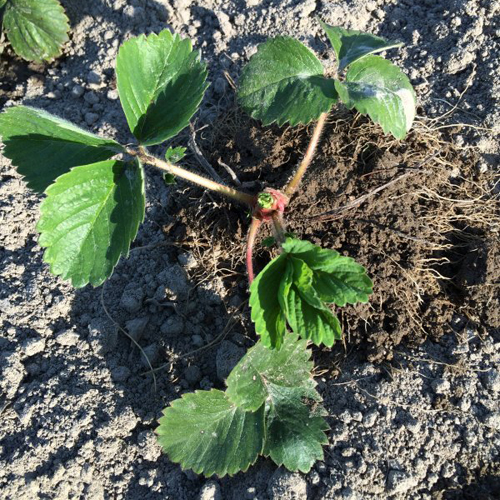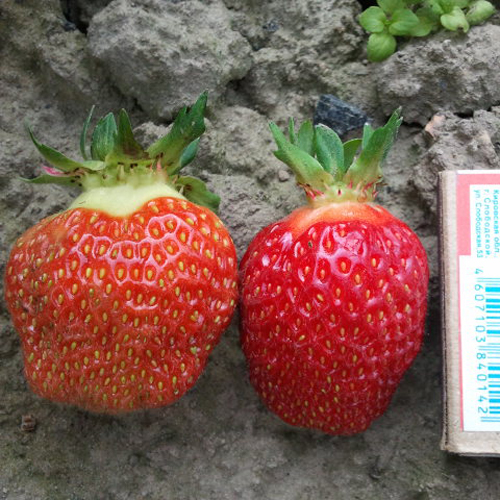Strawberry variety Elephant calf
Baby elephant is a non-repairable variety of garden strawberries (strawberries) of medium ripening. Bred by specialists of the Federal State Budgetary Scientific Institution "Federal Altai Scientific Center of Agrobiotechnology". In 1988, an application was filed for admission of the variety to cultivation, 18 years later, after passing the tests, it was included in the State Register of Breeding Achievements of the Russian Federation. Zoned in two regions of the country: West Siberian (Altai Republic, Novosibirsk, Kemerovo, Tomsk, Tyumen, Omsk Regions and Altai Territory) and East Siberian (Republics of Buryatia, Sakha (Yakutia), Khakassia, Tyva, Irkutsk Region, Transbaikal and Krasnoyarsk the edges). The baby elephant is very winter-hardy, so it can be grown in regions where other varieties simply do not take root due to the harsh cold climate. Along with all its advantages, which we will talk about below, strawberries have one serious drawback - the berries are very unstable to rot.

The plant is powerful, erect, spreading, abundantly leafy. The whiskers are pale pink, formed in medium quantities. Leaves are medium in size, concave, slightly wrinkled, green in color with a bluish bloom, dull. The teeth of the leaf plate are obtuse, narrow. The middle lobe of the leaf has an oval-rhombic shape. The petiole of the middle lobe of the leaf plate is the same in length as the lateral ones. The petiole is medium, with pubescence, the hairs are appressed. The flowers are bisexual, medium-sized, curled, white or cream-colored. The inflorescence is semi-sprawling, consists of a large number of flowers. Peduncles of medium length, thick and strong, multi-primordial, located at the level of the leaves, are laid on the ground under the weight of the crop.
The elephant's berries are very large, broadly ovoid without a neck, and can often be doubled. The peel is a deep red-scarlet color, shiny. Achenes yellow, depressed rather deeply. The pulp is red, moderately dense, without voids, fleshy, juicy, with a pronounced strawberry aroma. The taste of the berries is sweet and sour, some gardeners complain of too pronounced sourness, but this quality is more likely for an amateur, or it can be considered a feature of the variety. On the other hand, there are other reviews in which gardeners praise strawberries for their sweetness. In a word, the Elephant's taste is good, just not everyone will like it. The pulp of the fruit contains: 7.2% sugar, 0.8% acid, 875.2 mg% vitamin C.

The berries are versatile in use, excellent fresh, excellent for processing into preserves, jams, compotes, and are also great for freezing. The density of the pulp is enough to safely transport the crop over short distances, but there is no need to talk about high transportability and good keeping quality. And, to be honest, although the variety is declared as universal, it is still more suitable for cultivation for personal consumption. For commercial cultivation, it is better to look for another variety, especially since the choice is now huge.
The baby elephant is not distinguished by stable fruiting, the berries become smaller by the end of the season, which is why the weight indicators for the entire period are not particularly impressive - from 9.6 to 28.3 grams. At the first harvest, of course, strawberries will delight you with their large-fruited, the berries will be homogeneous, weighing about 20-30 grams, or maybe a little more. But by the last training camp, a frank trifle will already be formed on the bushes. Of course, this problem is completely solvable with good quality care and abundant feeding, since strawberries respond well to increased attention to themselves. On the other hand, the question arises - is it necessary to indulge the whims of our hero when there are many large-fruited analogues on the market that are distinguished by stable fruiting? Of course, it's up to you to answer this question. And it is worth saying that, after all, the Elephant has other advantages that can put him on the list of favorites when choosing a variety for growing.

According to the State Register of Plants of the Russian Federation, according to the results of state tests, the strawberry yield was 71.3−87.3 c / ha. But given that the variety is responsive to intensive agricultural technology, we can talk about indicators and more than 100 c / ha. Of course, at present such results cannot be called high, they are rather average. On the other hand, if you grow these strawberries for personal consumption, then such a yield will be quite enough, but for commercial use this is not enough. In addition, the productivity of our hero is highly dependent on the weather conditions of the season, and without "dancing with a tambourine" in problem periods, you can not count on a bountiful harvest.
The variety is quite resistant to various diseases, it is not affected more often than other varieties. But its main problem is the vulnerability of fruits to rot. And this is not just a small nuance, it is a really serious drawback. The berries begin to rot even with slight waterlogging, when you slightly overdid it with watering. And in rainy seasons, most of the crop can rot, and the one that remains will be too acidic. In general, our hero's relationship with water is very complicated, so be extremely careful with watering and take all the necessary measures to protect plants during periods of heavy rainfall.
Drought resistance and heat resistance of the Elephant is not bad, in hot seasons the berries become sweeter, but the yield may decrease in dry periods. In general, strawberries tolerate sharp temperature changes and various weather disasters quite firmly, but all these adversities can quite strongly affect the quality of the crop, and sometimes the quantity. But what our hero can definitely boast of is winter hardiness and frost resistance. It can deservedly be called one of the most attractive varieties for cultivation in areas with a cold, difficult climate. Given the regions in which strawberries are perfectly zoned, we can say that they are able to endure the most severe winters. Plants also tolerate spring frosts very calmly; freezing is extremely rare.
Elephant calf is quite simple in agricultural technology, does not require any special techniques. The main points to which you should pay special attention are regular preventive treatments against gray rot and control over the amount of watering. For the rest, the variety requires standard care, including weeding, loosening the soil, as well as top dressing, which are carried out as needed. By the way, the amount of fertilizer applied has a great influence on the size of the berries and their taste, so you should not complain about the bad and tasteless harvest if you have not provided the strawberries with good nutrition. And one more agrotechnical nuance that must be taken into account - do not thicken the planting. Bushes should be planted as far apart as possible, as far as the area of the allotted area allows. Firstly, the plants themselves are very voluminous, so they need quite a lot of space for normal development, and secondly, such a sparse planting will help reduce the risk of general damage to the berries by gray rot.
Well, let's summarize. Baby elephant is quite a good variety for growing in regions with cold climates. In such areas, it can really look advantageous against the background of popular foreign varieties, and may even surpass them in yield and taste. As for other regions, the choice of this strawberry for cultivation is very controversial, to be honest, and the reviews of gardeners confirm this. Many gardeners abandoned the Elephant, and not only because of the low resistance of the fruit to rot. It has an average yield, the size of the berries is not stable - you will see fruits weighing 30-40 grams only at the first harvest, and not throughout the season, as some nurseries loudly declare.
In general, against the background of many other varieties, including domestic selection, our hero looks very modest and cannot even show off his taste - too ambiguous reviews about them, and not every season the taste of berries will please you. Of course, there are also positive responses, someone is very happy with this strawberry.But we will be honest and say frankly - Baby elephant can really disappoint you, so before buying seedlings, you should immediately find a copy for comparison and then make a decision.








